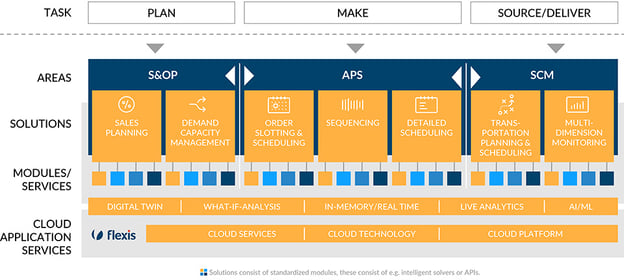Why Multimodal Logistics Is a Great Digital Strategy
Keith LaBotz - February 02, 2023

Supply chain digitalization is like rebuilding a plane in midflight; transportation is the engine, and if that fails, the supply chain goes down.
The chance of that happening is about 70%, according to McKinsey, BCG, KPMG, and Bain & Company. Any aircraft with those odds would be grounded, but supply chains are not so lucky: they cannot stop, nor can digitalization.
The only thing a company can do is figure out the optimal way to transform supply chain processes without disrupting business operations. The best strategy is focusing digitalization efforts around last-mile logistics; you can read more about that in a previous post.
This article examines the optimal starting point for that strategy: multi-modal and intermodal transportation.
Why multi-modal transportation? You’ll see why in just a minute, but first, you must understand the problem to appreciate this solution.
Transportation management solutions and warehousing operations often segregate shipping processes by mode, carrier, and distribution scenarios. Digitalization should follow this template, transforming each transportation area to minimize transition risk. Multi-modal and intermodal is one of these areas.
Why MultiModal is a Good Starting Point for Digitalization
- Most TMS apps need a lot of help with these shipments; multi-leg transportation moves are often managed using only the endpoints, limiting the visibility and optimization of these shipments.
- While many fleet management solutions can address multi-leg, multi-stop routing, it is rare to find these apps integrated with supply chain planning functions. A digital supply chain must include TMS and fleet management as part of the SCM, or supply chain operations cannot be fully optimized.
- The weak functionality and integration typically found in apps managing multimodal and intermodal shipments offer a relatively standalone, low-risk opportunity for digitalization.
Intermodal and Multimodal Similiarities
Intermodal and multimodal transportation are identical except for the contract and handling of shipping containers. The similarities are:
- Multiple modes of transportation are combined to move freight from the shipper to the final destination.
- Modes of transportation can include any means of conveyance required, including truck, rail, barge, ship, air freight, pipeline, bicycle, hand courier, or other.
- Transportation is executed in separate legs, typically managed by a different carrier specializing in a mode or geography.
Intermodal and Multimodal Differences
Multimodal transports a shipment under the terms of a single contract with a multimodal transport operator (MTO). The MTO is liable for the entire journey, even though transportation is subcontracted to different carriers. The original shipping container tendered may or not be transported. If the original container is not required, its contents can be loaded and transported.
Intermodal transports a shipper’s original shipping container to the final destination, and the shipper contracts with every carrier; there is no MTO. The container transfers from one leg of the journey to the next without carriers touching its contents.
Multimodal and Intermodal Benefits for Corporate Fleets
For companies managing a transportation fleet, multimodal and intermodal services can quickly bolster the transportation strategy.
Supporting this capability requires transportation routing software to create and optimize multi-leg transportation routes across multiple parties. Including third parties with corporate fleet routing must be seamless so managing the transfer of shipments to third parties (MTO or directly to the initial carrier) is seamless.
The benefits of adding multimodal and intermodal capabilities into transportation planning include the following:
- Adds Resilience Additional capacity is on tap for demand spikes, which is advantageous for rightsizing shipping operations.
- Minimizes Transportation costs. Limiting corporate assets for Pickup & Delivery (P&D) operations and outsourcing long-haul transportation can reduce fleet size without sacrificing quality.
- Reduces Carbon Emissions. Modes like barge, ship and rail are less expensive than trucks and emit far fewer greenhouse gases.
- Increases security of goods shipped (intermodal) Shipping containers remain sealed, and carriers do not handle goods shipped, reducing the likelihood of theft.
- Reduces freight claims for damages (intermodal) Shipment contents are not handled in each transfer, reducing the likelihood of breakage and misplaced cargo.
- Improves Supply Chain Optimization. Access to the open market presents greater flexibility in supply chain planning and execution.

The flexis cloud provides a quick, low-risk solution for planning multimodal and intermodal transportation. This solution can integrate S&OP, APS, and SCM (logistics) planning and execution with the TMS and VRS processes. It includes a holistic data model incorporating all transportation modes into long-range and daily supply chain optimization.
%20process.jpg?width=624&height=386&name=flexis%20Vehicle%20Routing%20and%20Scheduling%20(VRS)%20process.jpg)
flexis SCM Transportation Planning and Scheduling includes a VRS module for Vehicle Routing and Scheduling optimization that automates vehicle loading and scheduling for multi-stop delivery routes and linehaul transportation.
- Transportation planning optimizes fleets around cost and carbon emissions and considers all equipment, driver, and regulatory constraints.
- The optimal mix of modes and routes is determined for every shipment, evaluating a combination of corporate logistics assets, including alternate distribution points and multimodal options.
With the flexis cloud, any company can formulate and execute a multimodal strategy at minimal risk, time, and cost.
Conclusion
Multimodal and intermodal transportation offer significant benefits for shippers and an ideal starting point for digital transformation. Minimizing the transition risk, maximizing the benefits, and accelerating digitalization is best accomplished with a transportation planning solution that supports long-range demand planning and daily logistics execution.
flexis provides the technology and services needed to support a multimodal strategy and use it as a starting point for digital transformation.
If you want to learn more get your Guide to Logistics 4.0
In this Guide you will learn:
-
Why a strategic process in transportation planning is a top priority for digitalization
-
What megatrends will increase supply chain volatility
-
How to manage it
Want to learn more about Multimodal Transportation?
Download our presentation and learn:
-
How can transports be planned quickly and yet flexible so that CO2 savings are verifiable?
-
How do you make optimal use of a multimodal transport network that maintains supply in both the short and long term?
-
How can you more easily realize a modal shift when disruptions occur? And how do you keep a grip on your CO2 emissions in doing so?
flexis and BigMile present a Use Case of a modal shift and show that network optimizations and sustainability often go hand in hand.
LATEST POSTS
- Understand Why Production Planning Needs Specialized Solutions
- Understand Circular Economy in The Manufacturing Industry
- How Can Industry 4.0 IT Integration Be Achieved Smoothly?
- The Significance of Order Sequencing in Discrete Manufacturing
- How to improve your Supply Chain Management: The Power of Control Towers




